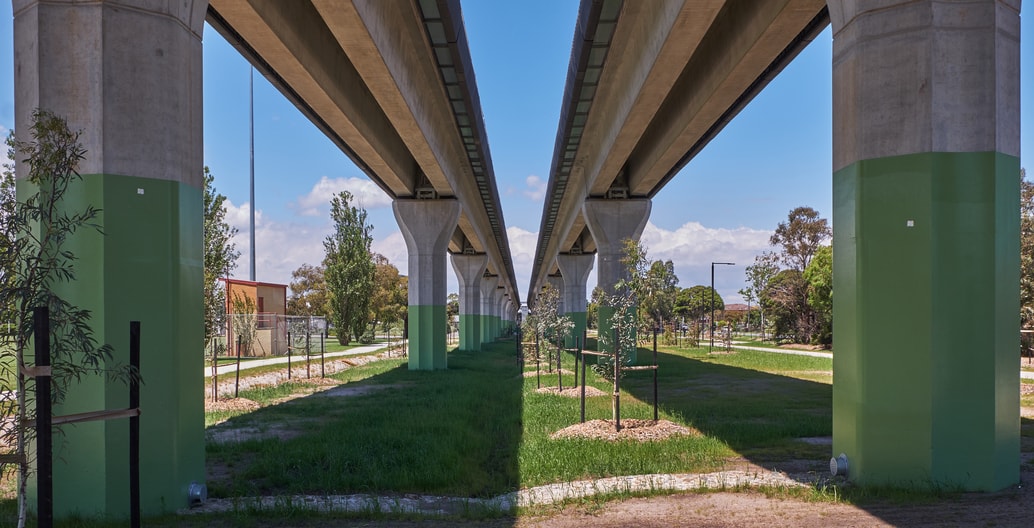
Elevated value: how is sky rail affecting real estate?
A new study has found that Melbourne’s level crossing removal project has increased property values in affected suburbs.
Value capture has been advocated as an innovative way to fund infrastructure, including by the Australian government. However, its effectiveness in Australia has been questioned. Our research, based on railway level crossing removals in Victoria, suggests infrastructure projects do lead to higher property values, which could be captured to contribute towards project funding.
At sites close to where level crossings were removed, property values increased by as much as a quarter. This highlights the opportunity to use a value capture model.
What’s the idea of value capture?
Infrastructure investment improves connectivity, leading to higher land or property values in areas that benefit from this. Value capture taps into this increased value – usually using some form of taxation – to help finance the infrastructure responsible for the increase.
Value capture has been widely used overseas. In the United Kingdom and Hong Kong, it has proved to be an effective way to fund major infrastructure.
This approach is not common in Australia, where most infrastructure projects are government-funded. Gold Coast Light Rail was developed with the aid of a levy on ratepayers.
However, a lack of funding means many large-scale infrastructure projects are not being funded at the same time. This highlights the need to find innovative ways to fund infrastructure, which includes exploring the potential benefits of value capture.
Financing infrastructure by value capture has been widely discussed and was considered by a parliamentary inquiry. The concept features prominently in the federal government’s Smart Cities Plan and would complement the Smart Cities vision for 30-minute cities.
Would it work in our low-density cities?
But there is a debate over how well this model would work in Australia. It’s argued the low-density nature of Australian cities would result in a lower level of value creation to be captured. Nevertheless, little empirical evidence is available on value creation in Australia.
Despite clear policy interest in how much land values increase following a new rail investment, and to what extent this can be attributed to the investment, much remains to be explained.
Our research based on the level-crossing removal project in Victoria found property values near each site could be enhanced significantly. The state government began the project in 2015. It aims to eliminate 75 dangerous and congested level crossings to improve traffic flows across metropolitan Melbourne. Our yet-to-be-published research is to be presented at the Pacific Rim Real Estate Society annual conference.
Importantly, this is one of the largest rail infrastructure projects in the state’s history. As of December 2017, the estimated budget for removing 50 level crossing sites was A$8.3 billion. The ultimate cost is likely to be greater as another 25 sites were added to the project in 2018 and 2019.
The work has caused inconvenience to local residents during construction and has limited capacity to ease traffic congestion. The pace of progress and budget blowouts “present risks to achieving value for money”, the state auditor-general reported.
Despite the temporary inconvenience during the construction phase, transport connectivity will be enhanced once the project is complete.
House values have risen, but variably
To offer some empirical evidence on the benefits created by level crossing removal projects enhancing housing value, we considered four sites in Bayswater, Mitcham, Glen Iris and St Albans.
We found the completion of a level crossing removal leads to an increase of 9 percent in house value, on average, within the area surrounding the site. This positive impact diminishes as the distance from the site increases. It vanishes beyond 1,400 metres.
We also found the impact of level crossing removals varies from site to site. House values in surrounding affected areas increased by 8.81 percent in Bayswater, 28.6 percent in Glen Iris, and 10.5 percent in St Albans, but by only 2.1 percent in Mitcham.
Comparable evidence is found for units in these areas: prices increased by 2.35 percent in Bayswater, 7.3 percent in Glen Iris and 6.53 percent in St Albans, but there was no significant increase for Mitcham.
Key takeouts
There are three takeouts from our research.
1) The level crossing removal project in Victoria did lead, in general, to higher property values. This highlights the need for a comprehensive plan aimed at maximising value capture opportunities.
2) Value capture is potentially a feasible model despite the low-density nature of Australian cities. However, its likely effectiveness varies considerably with location. This reinforces the importance of a comprehensive plan.
3) Given infrastructure is critical for urban development, governments should consider using value capture to fund infrastructure in a way that helps meet urban development needs and reduces the shortfall of dwellings in Australia.
–
Chyi Lin Lee is Associate Professor of Property, UNSW
Jerry Liang is a Lecturer in Property and Real Estate, Deakin University![]()
Kang Koo is a Lecturer in Property and Real Estate, Deakin University
This article is republished from The Conversation under a Creative Commons license. Read the original article.


